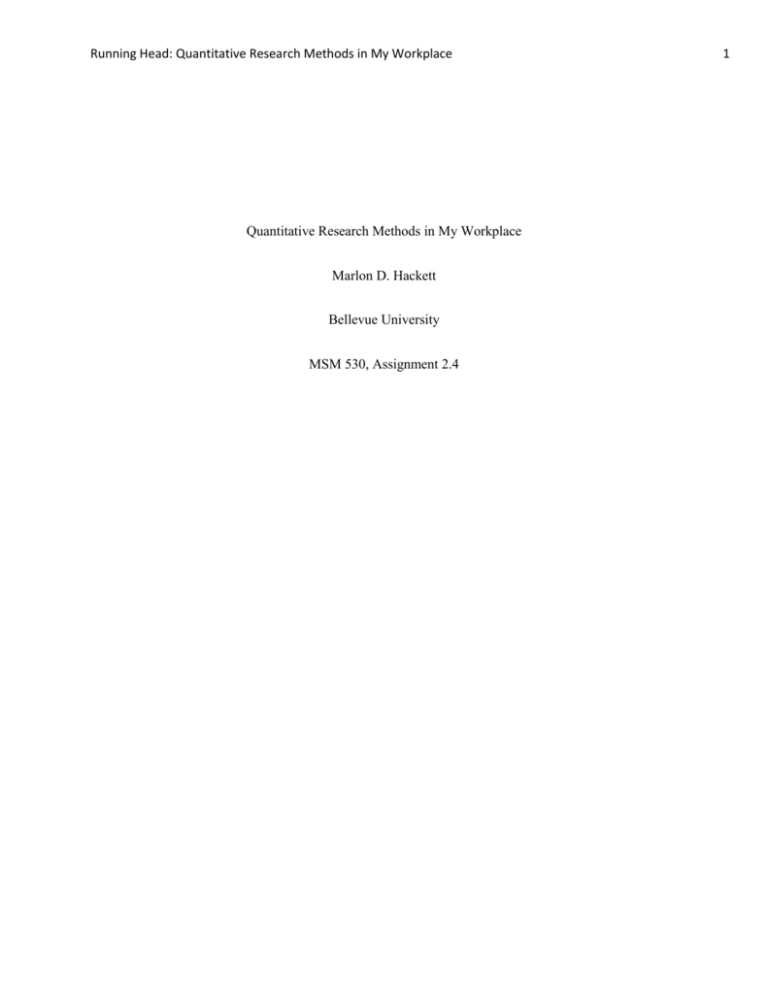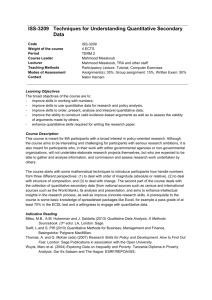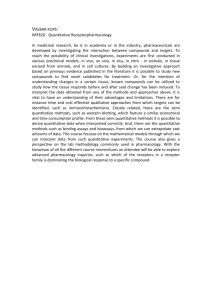Quantitative Research Methods in My Workplace
advertisement

Running Head: Quantitative Research Methods in My Workplace Quantitative Research Methods in My Workplace Marlon D. Hackett Bellevue University MSM 530, Assignment 2.4 1 Business Article Review 2 Quantitative Research Methods in My Workplace In my organization, quantitative research is applied in almost every aspect of operations and is used to develop policies that govern combat air bases throughout the entire Air Force (AF). In this paper I will briefly describe the nature of my organization, and how quantitative research is used in order to develop trend analysis, develop policies and provide understanding over various operational missions. Quantitative Research attempts precise measurement of something (Cooper & Schindler, p. 146). In my line of work, precise measurements are a vital aspect of daily operations. I work on a strategic level in the Air Force; the Air Combat Command Logistics Center (ACC/A4). ACC/A4 on a strategic scale ranks right below the Pentagon and is charged when overall operations, direction, policy and implantation of policy throughout every ACC base in the AF including all of the bases involved in the Middle East and Africa that are involved in warfare. These operations include fighter aircraft operations, equipment management support and special operations. My job entails managing equipment, equipment transfers, equipment authorizations and developing policies and regulations for the entire AF to follow. Being that the National Defense Authorization Act of Fiscal Year 2010 mandated that DOD be prepared to validate that its consolidated financial statements are audit-ready by September 30, 2017, the AF has been charged with streamlining procedures and resources in order to operate in the most cost effective manner possible (Government Accountability Office, 2011). To achieve such a monumental task, quantitative research is being used to aid us in developing new procedures to do so. Equipment assets in the AF that cost over $100,000 dollars or Capital Financial Assets (CFA) has been loosely accounted for in the past 10 years. In order for us to understand to what degree how badly these assets were being accounted for, we tasked every unit in the AF to perform a 100% physical inventory of these assets to gauge overall accountability over a 6 month period in 2012. From the statistical data we received, we were able to measure average inventory accuracy rates, the total dollar Business Article Review figures of missing assets and which units had a better handle of accountability than others. The data mentioned also aided us in correcting procedural problems that led to mis-reporting and asset loss. Ultimately, we were able to author new policies that made it easier for units to account for and keep track of their most expensive assets which in-turn saved the AF over $22 million dollars. In my organization, there are logistics representatives from every aspect of the AF; from aircraft maintenance functional managers to warehouse operations managers, we have the whole gamut. The expertise in the field of logistics is boundless in my organization. With that being said, one universal form of quantitative research that everyone measures and tracks is process man-hours. The ultimate goal of my organization is to make life easier for the entire AF by saving money, making policies easier to understand and implement, and to cut processes that simply cause more work than necessary. Manpower studies as well as man-hour studies are conducted on a monthly basis to gauge how long it takes for Airmen and civilians to complete processes; this is more of a logistics lean initiative. AF bases are surveyed by us in order to better understand how many people it takes and how long it takes to get the mission done. This research answers questions as to what resources are necessary to complete the mission, how much manpower should headquarters officials at the Pentagon figure into their equation to project fiscal year budgets, to gauge if the AF needs to lower manpower requirements and to streamline processes. From a strategic point of view, quantitative metrics are a vital part of decision making in my organization and the conclusions we draw ultimately affect higher AF decisions at the Pentagon. In conclusion, I view quantitative metrics and quantitative research as an instrumental tool that enables us to develop methodologies, policies and directives that are pivotal to easing operational constraints throughout the AF. This form of research has proven to be a key element in recognizing and developing trend analysis, understanding behaviors throughout lower-level organizations in the AF as well as serving as a key component in developing strategic AF strategies that are decided on by the Secretary of the AF as well as the Chairman of the Joint Chief of Staff. 3 Business Article Review 4 References U.S. Government Accountability Office (15 Sep, 2011) DOD FINANCIAL MANAGEMENT: Improvement Needed in DOD Components' Implementation of Audit Readiness Effort. Retrieved 13 June 2014 from: http://www.gao.gov/products/GAO-11-851 Cooper, D. R., & Schindler, P. S. (2011). Business Research (11th ed.). New York, NY: McGraw-Hill. pp. 144-145.





